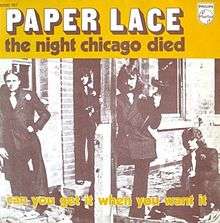The Night Chicago Died
| "The Night Chicago Died" | ||||
|---|---|---|---|---|
 | ||||
| Single by Paper Lace | ||||
| from the album And Other Bits of Material, Paper Lace (US Version) | ||||
| B-side | "Can You Get It When You Want It" | |||
| Released | 15 June 1974 | |||
| Format | 7" | |||
| Recorded | 1974 | |||
| Genre | Power pop, pop rock | |||
| Length | 3:30 | |||
| Label | Philips (UK), Mercury Records (US) | |||
| Writer(s) | Peter Callander, Mitch Murray | |||
| Producer(s) | Peter Callander, Mitch Murray | |||
| Paper Lace singles chronology | ||||
| ||||
"The Night Chicago Died" is a song by the British group Paper Lace, written by Peter Callander and Mitch Murray. The song reached number one on the Billboard Hot 100 chart for one week in 1974, reached number 3 in the UK charts, and number 2 in Canada. It is about a fictional shoot-out between the Chicago Police and members of the Al Capone Syndicate. The narrator retells his mother's anguish while awaiting news of the fate of her husband, a Chicago policeman.
History
"The Night Chicago Died" was Paper Lace's follow-up single to "Billy Don't Be a Hero", a #1 hit in the U.K. but virtually unheard in the U.S. where Bo Donaldson and the Heywoods' cover reached #1. Callander and Murray wrote both songs.
The U.S. single received a Platinum certification from the Recording Industry Association of America, signifying sales of at least one million copies. Though the song's story is set in the United States, Paper Lace were unable to perform the song live in the U.S. at the height of its popularity because of contractual issues.[1]
Accuracy
"The Night Chicago Died" is about a shoot-out between the Chicago Police and gangsters tied to Al Capone. It may have been inspired by the real-life Saint Valentine's Day Massacre, although that involved Capone's men killing seven of Bugs Moran's gang members and had nothing to do with the police.
The song's events supposedly take place "on the East Side of Chicago". Chicago has three commonly referred-to regions: the North Side, the West Side and the South Side. There is no East Side, as Lake Michigan is immediately east of Downtown Chicago. While there is an area of Chicago known as "East Side", it is a neighborhood on the Far South Side on the Illinois/Indiana state line. East Side is also several miles away from where Capone lived on Prairie Avenue in Chicago. Furthermore, in the 1920s, East Side was known for being a quiet, residential, and predominantly Eastern European neighborhood—a sharp contrast from the site of the bloodbath described in the song.
The songwriters said in interviews—most notably on Beat Club shortly after the song's smash success—that they had never been to Chicago before that time, and that their knowledge of the city and that period of its history had been based on gangster films.
Paper Lace did send the song to Mayor Richard J. Daley, who was not impressed with the song and greatly disliked it.[2]
Chart performance
Weekly singles charts
|
Year-end charts
|
Covers
- In 1974 Venezuelan singer Mirla Castellanos recorded her version of this song (translated to Spanish by her husband at the time, Miguel Ángel Landa) titled "La Noche De Chicago", which appeared on her album of the same name. Subsequently Castellanos made a new version of this song, which was included in her 1984 compilation album 16 Grandes Éxitos.
- Also, in 1974, Mexican group La Super Banda Macho recorded their own version of this song in Spanish titled "La Noche Que Murió Chicago", whose lyrics are very different from the previous version.
- In 1975 the Finnish singer Vicky Rosti recorded this song in Finnish language titled "Kun Chicago kuoli" (When Chicago Died), which was her debut single. The Finnish lyrics are almost verbatim translation of the English originals.
- In 1994 Mexican group Banda Toro recorded this song titled "La Noche Que Chicago Murió" in a Banda music style (but with the same lyrics of La Super Banda Macho's version). This song appeared on their debut album Banda Toro.
- In 2004 Mexican group Banda Machos covered this song titled "La Noche Que Murió Chicago" -and sounds very similar at the La Super Banda Macho's version- as part of their album Pura Pasión.
Citations
- The Night Chicago Died is used with some irony by Fox Mulder on "Die Hand Die Verletzt" episode of The X-Files as an example of "Devil's music".[7]
| Preceded by "Feel Like Makin' Love" by Roberta Flack |
Billboard Hot 100 number-one single 17 August 1974 (one week) |
Succeeded by "(You're) Having My Baby" by Paul Anka and Odia Coates |
References
- ↑ "Paper Lace Interview - Nottingham Culture". Leftlion.co.uk. Retrieved 2016-10-09.
- ↑ Fred Bronson. The Billboard book of number 1 hits. p. 373.
- 1 2 Steffen Hung. "Forum - 1970 (ARIA Charts: Special Occasion Charts)". Australian-charts.com. Retrieved 2016-10-09.
- ↑ "Image : RPM Weekly - Library and Archives Canada". Bac-lac.gc.ca. Retrieved 2016-10-09.
- ↑ "Top 100 1974 - UK Music Charts". Uk-charts.top-source.info. Retrieved 2016-10-09.
- ↑ "Top 100 Hits of 1974/Top 100 Songs of 1974". Musicoutfitters.com. Retrieved 2016-10-09.
- ↑ Chris Carter (1994–1995). Chris Carter Talks About Season 2: "Die Hand Die Verletzt" (featurette). The X-Files: The Complete Second Season: Fox.